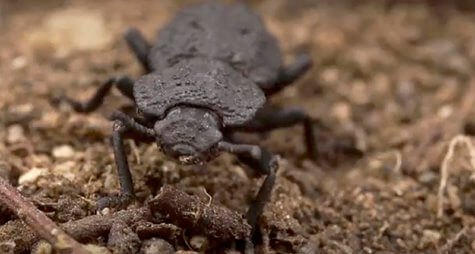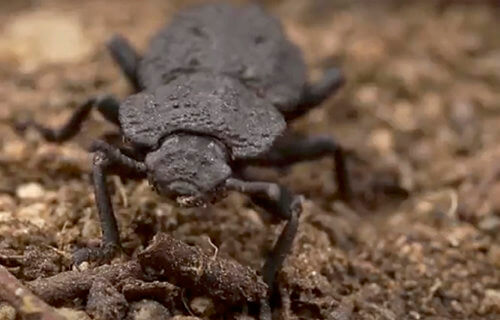
WEST LAFAYETTE, Ind. — When most animals get in the way of a car, things unfortunately don’t go well for them. A study finds there’s at least one bug that can be run over and keeps on walking: the diabolical ironclad beetle. Researchers say this beetle is so tough its shell is now giving engineers inspiration on how to make stronger materials to build machinery with.
You may be asking how a beetle could survive being driven over by a car. The study by a team from UC Irvine and Purdue University reveals diabolical ironclad beetles have a nearly indestructible exoskeleton. The strength lies in the bug’s two “elytron” which meet along a crease, called a suture, that runs the length of its abdomen.
For flying beetles, the armor-like elytra act as a protective casing for the insect’s wings. Diabolical ironclad beetles on the other hand don’t have wings. This bug’s elytra and connective suture help to transfer any force evenly across its body.
“The suture kind of acts like a jigsaw puzzle. It connects various exoskeletal blades – puzzle pieces – in the abdomen under the elytra,” explains Purdue’s Pablo Zavattieri in a university release.
Just how strong is the diabolical ironclad beetle?
The study shows just how amazing this jigsaw puzzle is when more force is applied to the beetle’s shell. Using compressive steel plates, researchers revealed the diabolical ironclad beetle can survive up to 150 newtons of force before its exoskeleton fractures. That’s the same as a load 39,000 times the insect’s body weight.
If that doesn’t sound impressive enough, the study explains that a car tire only applies about 100 newtons of force when hitting the ironclad beetle on dirt. Other non-flying beetles can only handle about half that much force.

Zavattieri’s lab also took CT scans of this incredible shell to see how the jigsaw successfully distributes all this weight. The study reveals two things happen when something tries to crush a diabolical ironclad beetle.
First, the interconnecting elytra lock into place to prevent themselves from being pulled out of the suture. This is very much like how puzzle pieces are shaped to lock together and not come apart. Second, the suture and blades divide into layers so they can deal with deformations more gracefully. This helps the shell avoid catastrophic failure.
Both of these processes help the beetle disperse energy and keep fatal injuries away from the bug’s neck.
Inspiring stronger machine parts
This unique and resilient beetle is giving the study authors new strategies on how to build more efficient machine parts. Unlike the ironclad, many manmade products don’t have a suture to hold everything together.
“An active engineering challenge is joining together different materials without limiting their ability to support loads. The diabolical ironclad beetle has strategies to circumvent these limitations,” explains David Restrepo from the University of Texas at San Antonio.
Heavy equipment like the gas turbines of aircraft need mechanical fasteners to hold them in place. These fasteners add weight and create stress that can lead to fractures and corrosion.
“These fasteners ultimately decrease the performance of the system and need to be replaced every so often. But the interfacial sutures of the diabolical ironclad beetle provide a robust and more predictable failure that could help solve these problems,” adds Maryam Hosseini, a postdoctoral researcher in Zavattieri’s group.
UC Irvine researchers have already built a carbon fiber composite fastener inspired by the diabolical ironclad beetle’s suture. The study finds this new fastener is just as strong as the typical machine part but is significantly more resilient.
“This work shows that we may be able to shift from using strong, brittle materials to ones that can be both strong and tough by dissipating energy as they break. That’s what nature has enabled the diabolical ironclad beetle to do,” Zavattieri concludes.
The study appears in the journal Nature.
This article was first published on October 22, 2020.
